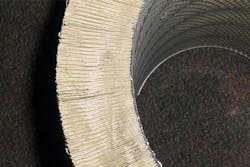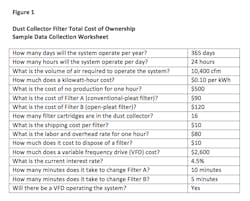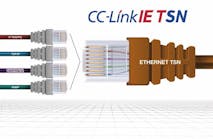WATCH THE ARCHIVED WEBCAST: HOW TO SAVE MONEY, TIME AND ENERGY ON DUST COLLECTION
When it comes to choosing filters for dust collection, plant engineers and maintenance professionals sometimes regard these items as more or less of a commodity. If Filter A and Filter B both offer the same rated efficiency and fill any special requirements — say, for example, the need for fire retardant media — then the lowest-priced filter would appear to be the better choice.
In fact, the opposite may be true. But it requires a "Total Cost of Ownership" (TCO) calculation to know for certain. TCO helps determine what it really costs to own dust collector filters… and how to save money, time and energy by choosing the best filters for your application.
Before starting a dust collection cost evaluation, make sure the filters considered have adequate filtration efficiency and other characteristics to perform their air pollution control function. OSHA has established permissible exposure limits (PEL) for hundreds of dusts ranging from nonspecific or "nuisance" dust to highly toxic substances. These limits are based on 8-hour time weighted average (TWA) exposure.
The limits on dust
For some dusts such as hexavalent chromium, a known carcinogen, OSHA has set thresholds as low as 5 micrograms (0.005 milligram) per cubic meter TWA. This is 10 times stricter than the limits for some other toxic dusts.
Dust collectors need to be equipped with very high efficiency filtration media to meet such requirements. In addition, the EPA is implementing strict new regulation on metal fabrication hazardous air pollutants (MFHAP) that will no longer allow plants in nine metal-fabricating and finishing-source categories to exhaust contaminated air outside. These emissions requirements may force plants to incorporate high efficiency filtration to ensure compliance.
How do you know if a dust collector filters complies with emission thresholds? The equipment supplier should provide a written guarantee stating the maximum emissions rate for the equipment over an eight-hour TWA. Filter efficiency stated as a percentage is not an acceptable substitute, even if the supplier promises 99.9 percent efficiency. OSHA and the EPA only care that the quantified amount of dust in the air is below established limits.
Also, what sizes and shapes of the dust particles are to be collected? Is the dust combustible? Is it sticky or dry? These characteristics also determine the best filter choice. Testing a sample of dust is the only way to get an accurate picture of its properties. Dust testing is available from independent laboratories and many equipment suppliers.
How much does a filter really cost?
- Energy – to operate the dust collector from day to day, including electrical costs, compressed air usage and CO2 emissions.
- Consumables – replaced periodically throughout the equipment life.
- Maintenance and disposal – time taken to service equipment and costs of consumables disposal.
If purchasing a new system, you control more of these variables, such as the selection of electrical components that impact energy use. Even if simply assessing what replacement filters to use in an existing collector, TCO analysis yields useful information.
Figure 1 is a sample dust collection worksheet used to gather TCO data. The following discusses some of key items that may be included in a worksheet and how they impact TCO.
Many factors influence a dust collector’s electrical energy consumption. Though a number of electrical loads are associated with a dust collector – timer boards, rotary airlock motors, etc. — the largest portion of the load relates to the fan or blower.
Understand that differential pressure losses are directly proportional to the amount of air moved through a system. The amount of air in turn is directly proportional to the cost of a fan’s electrical energy consumption. While ducting should be optimized at the time of installation to reduce pressure loss, energy control devices and filters also contribute to variable pressure losses during dust collector operation.
Variable speeds help
When running a dust collector with a constant speed fan (i.e., with no energy control device), the amount of air moving through the collector varies during the filter service life. When filters are clean and differential pressure is at its lowest, more air blows through the system than required. As filters become loaded with dust, static pressure is increased and less air is moved as a result. Thus, Filters use more energy in the early stages of service life.
A mechanical damper at the blower outlet alleviates this problem. Depending on filter used, periodic adjustment of the damper to regulate air flow can save an average of 1" w.g. of static pressure over the life of the filter.
A far more effective approach is use of a variable frequency drive (VFD) that electrically controls fan speed. When filters are new, speed is decreased. When filters become loaded, a constant air flow is maintained. The electrical control is highly efficient in maintaining desired air flow, and energy consumption is greatly decreased. VFDs are proven to save an average of 4" w.g. of static pressure over the life of the filter. Added capital cost of installing a VFD on a dust collector varies, but return on investment is typically under one year.
Other considerations
Additional factors that impact energy use are:
- Used to power a dust collector fan, a premium efficiency motor pays for itself in reduced electrical power use, rebates and incentive programs. These motors run cooler and last longer, and are ideal with VFDs.
- Compressed air required to perform pulse-cleaning of filters and to maintain a lower pressure drop will vary significantly depending on filter design.
- Although it doesn’t contribute tangibly to TCO, CO2 emissions from operation of a dust collector should be considered and stated as a cost impact on the environment.
What’s more, cartridge replacement, as well as transportation, inventory, labor and disposal costs all need to be considered. The amount of time lost to production when a dust collector must be shut down can also be a significant cost.
Clearly, when viewed on an annualized basis, all of these factors are largely dependent on the anticipated service life of the filter. A change-out schedule will determine how many filters you can expect to buy, transport, store and dispose, as well as the costs of labor and downtime associated with filter service.
For further discussion and a detailed example of a TCO cost comparison applied to duct-collection filters, view our webinar.



